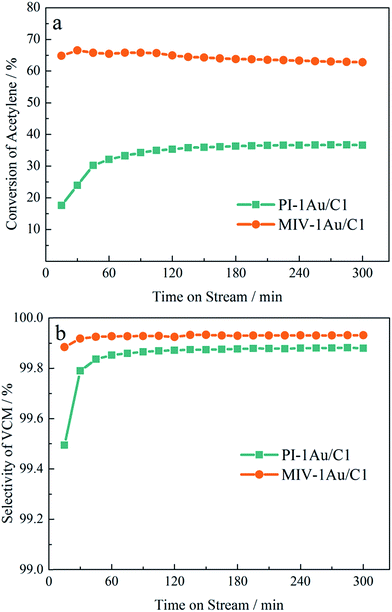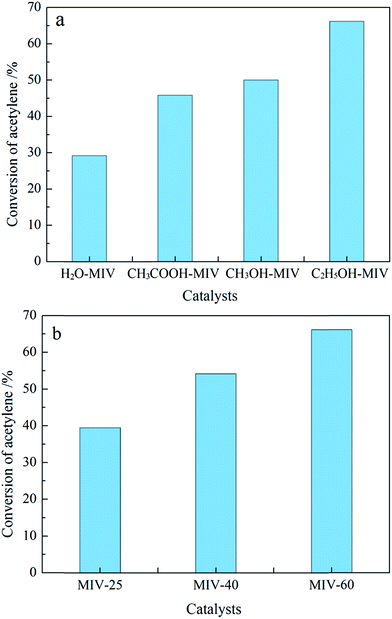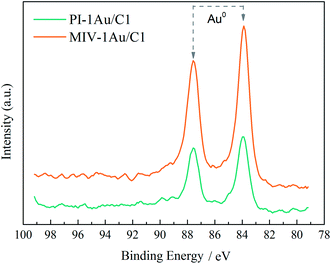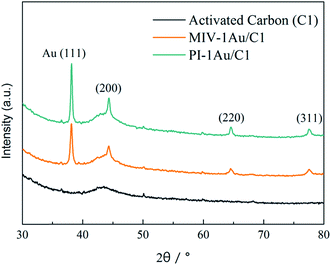Efficient Au0/C catalyst synthesized by a new method for acetylene hydrochlorination†
Xiaohui Tian,
Guotai Hong,
BinBo Jiang*,
Feipeng Lu,
Zuwei Liao,
Jingdai Wang and
Yongrong Yang
State Key Laboratory of Chemical Engineering, College of Chemical and Biological Engineering, Zhejiang University, Hangzhou 310027, P. R. China. E-mail: Jiangbb@zju.edu.cn
First published on 8th May 2015
Abstract
A new impregnation method, involving a mixture of solvents and a vacuum drying process, was used to prepare a gold catalyst (MIV-1Au/C1) for acetylene hydrochlorination. It was found that MIV-1Au/C1 was twice as active as the catalyst prepared through the traditional method (PI-1Au/C1). The new method is green, mild and simple. Moreover, it appears to be controllable by tuning solvent and temperature. Excellent Au dispersion in MIV-1Au/C1 was revealed by transmission electron microscopy (TEM). In addition, X-ray photoelectron spectroscopy (XPS) profiles proved that Au0 was the only active species of MIV-1Au/C1 at the initial/highest point of testing. Further XPS results showed that Au0 could be oxidized to Au3+ during the reaction along with the deactivation of MIV-1Au/C1. Thus, Au0 appeared to be preferred for the catalytic route. Our findings demonstrate that this new method has potential as a catalyst for acetylene hydrochlorination. Moreover, this study highlighted the importance of Au0 in this field.
1 Introduction
Since 1980s gold has become one of the most popular topics in catalysis.1–7 As one of the two typical catalytic systems that originally unveiled the mystery of gold catalysis,1,2 acetylene hydrochlorination (C2H2 + HCl → C2H3Cl), which accounts for nearly 40% of the global polyvinyl chloride (PVC) production ability, has drawn more and more attention in recent years. Because of the extensive environmental concerns with commercial mercury-based catalysts for acetylene hydrochlorination, gold catalysts, especially AuCl3, have become the most promising substitutes.8–16Although nearly all of the past investigations in this field have focused on Au3+, the activity of Au0 should not be completely ignored. For example, Nkosi and Hutchings17 prepared Au0/C catalysts by the thermal decomposition of immobilized AuCN in activated carbon. Performance tests showed that the resulting activity was competitive with Au3+ catalysts along with being more stable. In addition, Wittanadecha and coworkers14 prepared Au0/C catalysts using a microwave assisted impregnation method, which were quite active for this reaction. However, the synthesis procedures proposed by Nkosi and Hutchings were hazardous and expensive since toxic AuCN was used as a precursor. Therefore, their Au0 featuring catalyst failed to draw broad attention. Furthermore, the method proposed by Wittanadecha still required hazardous aqua regia as a solvent to improve the dispersion of Au during the impregnation step. In spite of the complexity in operation, aqua regia will inevitably influence the surface properties of the carbon materials,18,19 which are entangled with the final catalytic performance.20–22 According to the investigations of Conte and Hutchings,12 such a situation was unfavored because it complicated further in-depth investigations into the active sites. Because of these shortcomings, Wittanadecha's method was not appropriate for the investigation of Au0. Therefore, it is imperative to develop a simpler and more effective method to synthesize Au0-based catalysts for acetylene hydrochlorination.
As is known, the catalytic efficiency of Au0 catalysts is closely related with the dispersion degree of Au nanoparticles (AuNPs). In addition, the traditional pore-volume impregnation (PI) method is extensively used to prepare gold catalysts for acetylene hydrochlorination. However, without the help of aqua regia, the PI method is inefficient for obtaining small AuNPs.6 To solve this contradiction, an impregnation method using a green mixture of solvents, as well as a vacuum drying process is introduced to synthesize an Au0/C catalyst for acetylene hydrochlorination. This technique, referred to as the MIV (“M” for mixed solvents; “I” for impregnation; “V” for vacuum drying) process, has been used by our group to synthesize composite supports.23 To the best of our knowledge, this method has not been used to prepare gold catalysts for acetylene hydrochlorination to date. We adopt this method because it is simpler than other methods designed to prepare Au0 catalysts such as the coprecipitation and sol–gel methods. Moreover, our method is much greener since it involves only green agents and mild drying conditions. Experiments testify that the MIV method is much more efficient than the PI method.
2 Experimental
2.1 Catalyst preparation
Impurities on the carbon surface were removed by acid washing according to our previous report.23 Morphology and textural properties of the pretreated carbon (C1) are given in Fig. S1 and Table S1 in the ESI.† The catalysts of this article had a nominal Au content of 1.0 wt% and the actual Au contents determined by inductively coupled plasma atomic emission spectroscopy (ICP-AES) were used for further detailed discussions.Our MIV process involves the addition of ethanol to HAuCl4·4H2O aqueous solution, impregnation and subsequent vacuum drying steps (Scheme 1). Since we found that the strong reducing ability of activated carbon24,25 could help realize the full reduction of HAuCl4, no reducing agent was needed during the MIV process. The MIV method was as follows: HAuCl4·4H2O was dissolved in a mixture of water and ethanol, wherein the solution volume was 3.2 times of the total pore volume of C1. In addition, the volume of ethanol was 2.25 times the volume of water. The HAuCl4·4H2O solution was then added dropwise to the acid-washed carbon while shaking. The resulting wet sample was then dried at 60 °C for 6 h in a vacuum of −95 kPa to vaporize the solvents. Finally, the product was dried in air at 140 °C for 12 h to get rid of any trace moisture in the carbon before being collected for use. The final catalyst was denoted as MIV-1Au/C1.
For comparison, gold catalyst prepared with the pore-volume impregnation (PI) technique was denoted as PI-1Au/C1. In contrast to other reports, we used H2O to replace aqua regia to dissolve HAuCl4·4H2O. In this case, Au0 could be produced by the reducing ability of the carbon surface. Appropriate amount of HAuCl4 aqueous solution (1.2 times of the pore volume of carbon) was added dropwise to the activated carbon support while shaking. Furthermore, the wet product was maintained at room temperature for 2 hours to gain better impregnation. The sample was then dried at 140 °C for 12 h before being collected for use.
ICP-AES revealed that the Au content in PI-1Au/C1 and MIV-1Au/C1 was 0.983 and 0.924 wt%, respectively.
2.2 Catalyst testing
The hydrochlorination of acetylene was carried out in a fixed bed laboratory microreactor. Catalysts were tested using a stainless steel reactor tube (inner diameter of 8 mm). 0.5 g of the synthesized catalyst was sandwiched between glass pearls inside the reactor for each run. N2 was used as the purging gas and the reactor was operated at atmospheric pressure at 180 °C in down-flow mode. After being heated at 180 °C, hydrogen chloride regulated by mass flow controllers was fed into the reactor for 10 min to remove the N2 adsorbed in the catalysts. Furthermore, acetylene was introduced into concentrated sulfuric acid to remove trace poisonous impurities, such as acetone, moisture, S, P and As, and subsequently fed into the reactor to start the reaction. The pressures of the reactants, namely, HCl and C2H2, were chosen for safety and in accordance with industrial conditions.A total GHSV (gas hourly space velocity) of 9800 h−1, which gave a total MHSV (mass hourly space velocity) of 27.7 h−1, was chosen for catalyst testing. Conversion of acetylene was not too high in this situation, thus all results obtained were in the kinetic regime.26 A reactor loaded with 0.5 g bare activated carbon presented only slight reactivity for the hydrochlorination of acetylene (<0.5% conversion of acetylene). The gas product was passed through a vessel filled with 15% sodium hydroxide solution and a drying tube to remove the remaining hydrogen chloride and moisture. The composition of the effluent was determined immediately using a gas chromatography equipped with a flame ionization detector. Catalytic performance was evaluated by conversion of acetylene (XA), selectivity of VCM (SVCM) and deactivation rate (DR):
| XA = φVCM × 100% | (1) |
| SVCM = φVCM/(1 − φA) × 100% | (2) |
| DR = −(XLA − XHA)/t × 100% | (3) |
The specific rate of a catalyst was calculated based on the ICP-AES determined mass loading of Au in the catalyst:2
 | (4) |
2.3 Catalyst characterization
X-Ray photoelectron spectroscopy (XPS) analysis were performed by an ESCALAB 250 Xi XPS system from Thermo Fisher Scientific, England, and excited by monochromatic Al Kα radiation (1486.6 eV). All binding energies were calibrated using the C(1s) carbon peak (284.6 eV).X-Ray powder diffraction spectra (XRD) were acquired with a Philips PW3050/60 vertical goniometer using Ni-filtered Cu Kα1 radiation (λ = 1.5406 Å) using a proportional counter and a 0.02° step size in the 2θ range from 5° to 80°. The assignment of the various crystalline phases is based on the JPDS powder diffraction file cards.
The size of the AuNPs was determined by transmission electron microscopy (TEM). A JEM 2100F field emission transmission electron microscope (JEOL) working at 200 kV was used to acquire the images.
The actual Au content in the catalysts was determined by ICP-AES using an ICAP 6300 (Thermo, MA). The sample was dried at 140 °C for 12 h before an accurate weighing and digestion process.
3 Results and discussion
3.1 Catalytic performance
Fig. 1 shows the catalytic performance of PI-1Au/C1 and MIV-1Au/C1. Based on the ICP-AES results and Fig. 1(a), the calculated specific rate of PI-1Au/C1 (Au 0.983 wt%) was 15.3 mol g−1 h−1. For MIV-1Au/C1 (Au 0.924 wt%), a specific rate up to 29.7 mol g−1 h−1 was reached. Thus, the activity of MIV-1Au/C1 was about twice as high as PI-1Au/C1. It should be noted that the mild conditions involved in the MIV process had a negligible influence on the carbon properties, which is crucial for catalytic performance.12 Therefore, further investigations on active sites will be convenient.The selectivity of MIV-1Au/C1 and PI-1Au/C1 were both extremely high (Fig. 1(b)), similar to gold catalysts reported by other researchers.8,15 PI-1Au/C1 showed an induction period of 3 h. By contrast, MIV-1Au/C1 reached its highest efficiency immediately after the reaction was initiated. This situation implies that MIV-1Au/C1 had adequate active sites at its surface after preparation, while PI-1Au/C1 required activation to gain the best performance. From this viewpoint, MIV-1Au/C1 is more suitable than PI-1Au/C1 for further study.
Further experimental results showed that the performance of the MIV process was related to the composition of the solvent and the vacuum-drying temperature. As shown in Fig. 2(a), if the composition of the impregnating solvent (ethanol/water) was changed by replacing ethanol with water, acetic acid or methanol (keeping the solution volume at 3.2 times of the total pore volume of C1), the resulting specific rates varied from 12.5 to 21.4 mol g−1 h−1, lower than the case when ethanol was used (MIV-1Au/C1). In addition, lower specific rates of 16.9 and 23.3 mol g−1 h−1 were obtained if the impregnated samples, using ethanol and water as the impregnating solvent, were vacuum-dried at 25 and 40 °C respectively, instead of at 60 °C (Fig. 2(b)).
These findings implied that the choice of solvent and drying temperature was crucial for the MIV process, probably because solvent could influence the transportation of Au species into the support, while drying temperature determined the immobilization of those Au particles. That is to say, both solvent and vacuum drying temperature had an impact on the crystallization process of Au species, which would modify the distribution of Au in the different samples. Thus, according to Fig. 2, it might be the case that the MIV process is controllable by adjusting the composition of the impregnating solvent and the vacuum drying temperature. According to the current data, the mixture of ethanol and water as well as 60 °C vacuum-drying seemed to be proper choices. Additional parameters, namely, the volume of the solvent and the vacuum degrees, still need further investigations. This will be explored in our future study.
3.2 State of gold in the fresh catalysts
Fig. 3 shows the XPS analysis of PI-1Au/C1 and MIV-1Au/C1. It is immediately evident that both PI-1Au/C1 and MIV-1Au/C1 have no Au3+ species9,12 at their surfaces. As was stated previously, the emergence of the large amount of Au0 was associated with the high reducing ability of activated carbon.24,25 It seemed that without strong oxidants such as aqua regia, Au3+ was unstable at the reducible surface of activated carbon. This phenomenon is in agreement with the literature. Usually, only small amounts of Au3+ could be acquired even if aqua regia was used as the impregnating solvent.8,12,27 The higher XPS intensity of MIV-1Au/C1 implied that a higher dispersion degree was obtained since XPS is a surface technique and the signal strength is a function of the ratio of surface to bulk atoms.9The crystalline form of Au was then determined by XRD techniques. XRD spectra of C1, PI-1Au/C1 and MIV-1Au/C1 catalysts are shown in Fig. 4. The broad peaks observed in the XRD pattern of C1 in the range of 2θ = 40–48° are typical of carbon materials, implying that is has an amorphous framework. Moreover, weak signals at 2θ = 36.5°, 50.1°, 60° and 68.1° are displayed and assigned to (110), (112), (211) and (203) facets of α-quartz (JCPDS PDF-46-1045), respectively. For PI-1Au/C1 and MIV-1Au/C1, very strong peaks at 2θ of 38°, 44.3°, 64.5°, and 77.5° were attributed to the (111), (200), (220) and (311) diffractions of face-centered cubic (FCC) metallic gold (JCPDS PDF-04-0784), respectively. The presence of Au0 peaks was in agreement with the XPS results.
To determine the dispersion degree of AuNPs in both catalysts, TEM was applied. Representative TEM images of PI-1Au/C1 and MIV-1Au/C1 are displayed in Fig. 5. Plenty of small and isolated AuNPs could be discerned in both samples while some apparent differences could be easily identified. Following the PI method, the resulting AuNPs diversified in shape (Fig. 5(a)). This was in line with previously reported Au/C catalysts that were synthesized according to the impregnation method.8,15 With more than 60% AuNPs in the size range of 8–12 nm, the mean AuNPs size in PI-1Au/C1 was determined to be 10.6 nm. In stark contrast to PI-1Au/C1, MIV-1Au/C1 showed the most peculiar characteristic of spherical AuNPs (Fig. 5(b)), which might be triggered by the interfacial tension between water and ethanol and their difference in evaporability. In addition, the mean particle size in MIV-1Au/C1 was determined to be 5.2 nm, which is much smaller than that in PI-1Au/C1. It should be noted that very small AuNPs with diameters of 2–6 nm accounted for about 60% of AuNPs in this sample, implying an excellent dispersion of gold. This could be attributed to the rapid evaporation of ethanol under the heated vacuum circumstance, which may cause the fast nucleation of gold species rather than growth of crystallites. Such an achievement clearly confirmed that the MIV method was effective in the synthesis of small AuNPs. The resulting AuNPs exhibited high activity since spherical and smaller AuNPs could provide more surface atoms and defects for the catalytic process.28
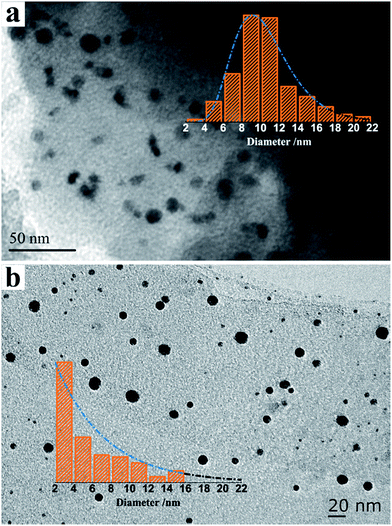 | ||
| Fig. 5 TEM images and histograms showing the distribution of AuNPs (inset): (a) PI-1Au/C1 and (b) MIV-1Au/C1. | ||
The most inactive sample in each experimental set of Fig. 2, referred to as H2O-MIV-1Au/C1 and MIV-25-1Au/C1, were also characterized to illuminate the influence of solvent and vacuum-drying temperature. XPS results (Fig. S2†) testified the presence of 100% Au0 in both samples, while the signal strength was much smaller than MIV-1Au/C1, implying lower surface/bulk Au ratios. TEM further confirmed the XPS results since only big clusters of AuNPs were discerned in both of the two catalysts (Fig. S3†), which was indicative of poor gold dispersion. This firmly proved that solvent and vacuum-drying temperature could greatly influence the crystallization process of gold species during the MIV process.
3.3 Evolution of Au0 during the reaction
Although only Au0 could be detected in the fresh catalysts, Nkosi17 and Wittanadecha14 have mentioned that HCl could oxidize Au0 to Au3+ through coordination to surface gold atoms. Therefore, the active site of the catalysts should be discussed in a more rigorous way. It is necessary to monitor the evolution of Au species during the experimental processes to distinguish the contributions of different Au species to the catalytic activity. MIV-1Au/C1 was chosen for this analysis because it was much more active and did not need any activation. The latter feature meant that no transformation of active sites was required to reach the highest catalytic efficiency.In our experiments, oxidation of Au0 might take place during the HCl purging process before the reaction started (10 min, subsection 2.2). Moreover, Au0 might be oxidized during the reaction.
To clarify the initial Au3+ content at the starting point of the performance tests, the XPS spectrum of MIV-1Au/C1 after HCl purging was taken. No signal of Au3+ exceeded the noise levels of the equipment was viewed (ESI, Fig. S4†). Furthermore, after 15 min of acetylene hydrochlorination, no obvious Au3+ signal emerged (ESI, Fig. S5†). Thus, no apparent transformation of the active sites happened during these short periods. Accordingly, the initial/highest activity of MIV-1Au/C1 was totally attributed to Au0.
By contrast, as the testing time was lengthened, Au3+ content markedly increased at the surface of MIV-1Au/C1, as shown in Fig. 6. This clearly confirmed the oxidation of Au0 by HCl. However, the increase in Au3+ content was much more significant than the decrease in activity (Fig. 6(b) and S6†). That is, the two quantities are not proportional to each other, still suggesting that Au0 was the main active species.
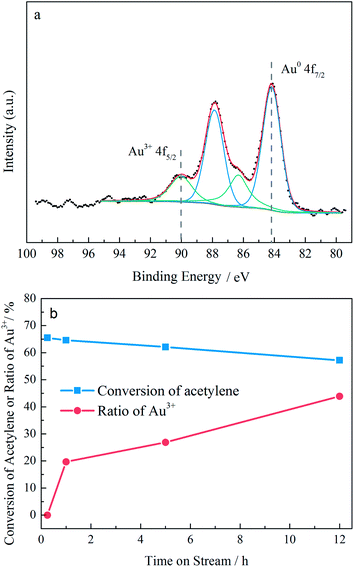 | ||
| Fig. 6 Valence change of Au: (a) XPS spectra of spent MIV-1Au/C1 after 300 min testing; (b) evolution of catalytic activity and Au3+ content during the testing duration. | ||
4 Conclusions
An impregnation method, involving mixed solvents and a vacuum-drying process, referred to as MIV method, was introduced to prepare gold catalysts (MIV-1Au/C1) for acetylene hydrochlorination. With a specific rate up to 29.7 mol g−1 h−1, MIV-1Au/C1 appeared to be twice as active as the catalyst prepared by the traditional PI method (PI-1Au/C1), testifying that the MIV method was applicable for this reaction. The MIV method involved only green solvents and mild conditions, hence it had a negligible influence on the surface properties of the support. Such achievement will simplify further investigations on gold active sites. Moreover, it was demonstrated that both the solvent and vacuum-drying temperature were key parameters for determining the final quality of MIV process, making the MIV method adjustable.Only Au0 was present at the surface of the resulting MIV-1Au/C1 catalyst, which was in the FCC form. TEM observations revealed a mean AuNPs size of 5.2 nm in MIV-1Au/C1, which was much smaller than that in PI-1Au/C1. Thus, gold dispersion in MIV-1Au/C1 was much higher. It was proven that Au0 was the only active species that enabled the initial/highest activity of MIV-1Au/C1. Further analysis testified that Au0 could be oxidized to Au3+ during the reaction. However, the increase in Au3+ content was much more significant than the decrease in activity. This non-proportional relationship suggested that Au0 was the main active species in our catalyst.
Acknowledgements
The authors gratefully acknowledge the support and encouragement of the National Natural Science Foundation of China (21176208), the National Basic Research Program of China (2012CB720500) and the Fundamental Research Funds for the Central Universities (2011QNA4032).References
- G. J. Hutchings, J. Catal., 1985, 96, 292–295 CrossRef CAS.
- B. Nkosi, N. J. Coville and G. J. Hutchings, Appl. Catal., 1988, 43, 33–39 CrossRef CAS.
- M. Haruta, Nature, 2005, 437, 1098–1099 CrossRef CAS PubMed.
- A. S. K. Hashmi and M. Rudolph, Chem. Soc. Rev., 2008, 37, 1766–1775 RSC.
- A. S. K. Hashmi, Angew. Chem., Int. Ed., 2005, 44, 6990–6993 CrossRef CAS PubMed.
- G. C. Bond, C. Louis and D. T. Thompson, Catalysis by Gold, Imperial College Press, 2006 Search PubMed.
- C. M. Friend and A. S. K. Hashmi, Acc. Chem. Res., 2014, 47, 729–730 CrossRef CAS PubMed.
- M. Conte, A. F. Carley, C. Heirene, D. J. Willock, P. Johnston, A. A. Herzing, C. J. Kiely and G. J. Hutchings, J. Catal., 2007, 250, 231–239 CrossRef CAS PubMed.
- M. Conte, A. F. Carley, G. Attard, A. A. Herzing, C. J. Kiely and G. J. Hutchings, J. Catal., 2008, 257, 190–198 CrossRef CAS PubMed.
- S. Wang, B. Shen and Q. Song, Catal. Lett., 2010, 134, 102–109 CrossRef CAS.
- X. Li, M. Zhu and B. Dai, Appl. Catal., B, 2013, 142–143, 234–240 CrossRef CAS PubMed.
- M. Conte, C. J. Davies, D. J. Morgan, T. E. Davies, D. J. Elias, A. F. Carley, P. Johnston and G. J. Hutchings, J. Catal., 2013, 297, 128–136 CrossRef CAS PubMed.
- Y. Pu, J. Zhang, X. Wang, H. Zhang, L. Yu, Y. Dong and W. Li, Catal. Sci. Technol., 2014, 4, 4426–4432 CAS.
- W. Wittanadecha, N. Laosiripojana, A. Ketcong, N. Ningnuek, P. Praserthdam, J. R. Monnier and S. Assabumrungrat, Appl. Catal., A, 2014, 475, 292–296 CrossRef CAS PubMed.
- K. Zhou, W. Wang, Z. Zhao, G. Luo, J. T. Miller, M. S. Wong and F. Wei, ACS Catal., 2014, 4, 3112–3116 CrossRef CAS.
- H. Zhang, B. Dai, X. Wang, W. Li, Y. Han, J. Gu and J. Zhang, Green Chem., 2013, 15, 829–836 RSC.
- B. Nkosi, M. D. Adams, N. J. Coville and G. J. Hutchings, J. Catal., 1991, 128, 378–386 CrossRef CAS.
- R. Burgess, C. Buono, P. R. Davies, R. J. Davies, T. Legge, A. Lai, R. Lewis, D. J. Morgan, N. Robinson and D. J. Willock, J. Catal., 2015, 323, 10–18 CrossRef CAS PubMed.
- C. Buono, P. R. Davies, R. J. Davies, T. Jones, J. Kulhavy, R. Lewis, D. J. Morgan, N. Robinson and D. J. Willock, Faraday Discuss., 2014, 173, 257–272 CAS.
- C. Bianchi, S. Biella, A. Gervasini, L. Prati and M. Rossi, Catal. Lett., 2003, 85, 91–96 CrossRef CAS.
- M. L. Toebes, Y. Zhang, J. Hájek, T. A. Nijhuis, J. H. Bitter, A. Josvan Dillen, D. Y. Murzin, D. C. Koningsberger and K. P. de Jong, J. Catal., 2004, 226, 215–225 CrossRef CAS PubMed.
- A. Villa, D. Wang, N. Dimitratos, D. Su, V. Trevisan and L. Prati, Catal. Today, 2010, 150, 8–15 CrossRef CAS PubMed.
- X. Tian, G. Hong, Y. Liu, B. Jiang and Y. Yang, RSC Adv., 2014, 4, 36316–36324 RSC.
- S. Chen and H. Zeng, Carbon, 2003, 41, 1265–1271 CrossRef CAS.
- D. A. Bulushev, I. Yuranov, E. I. Suvorova, P. A. Buffat and L. Kiwi-Minsker, J. Catal., 2004, 224, 8–17 CrossRef CAS PubMed.
- G. C. Bond, C. Louis and D. T. Thompson, Catalysis by Gold, Imperial College Press, 2006 Search PubMed.
- H. Zhang, B. Dai, W. Li, X. Wang, J. Zhang, M. Zhu and J. Gu, J. Catal., 2014, 316, 141–148 CrossRef CAS PubMed.
- P. Claus, H. Hofmeister and C. Mohr, Gold Bull., 2004, 37, 181–186 CrossRef CAS.
Footnote |
| † Electronic supplementary information (ESI) available. See DOI: 10.1039/c5ra06552f |
| This journal is © The Royal Society of Chemistry 2015 |


